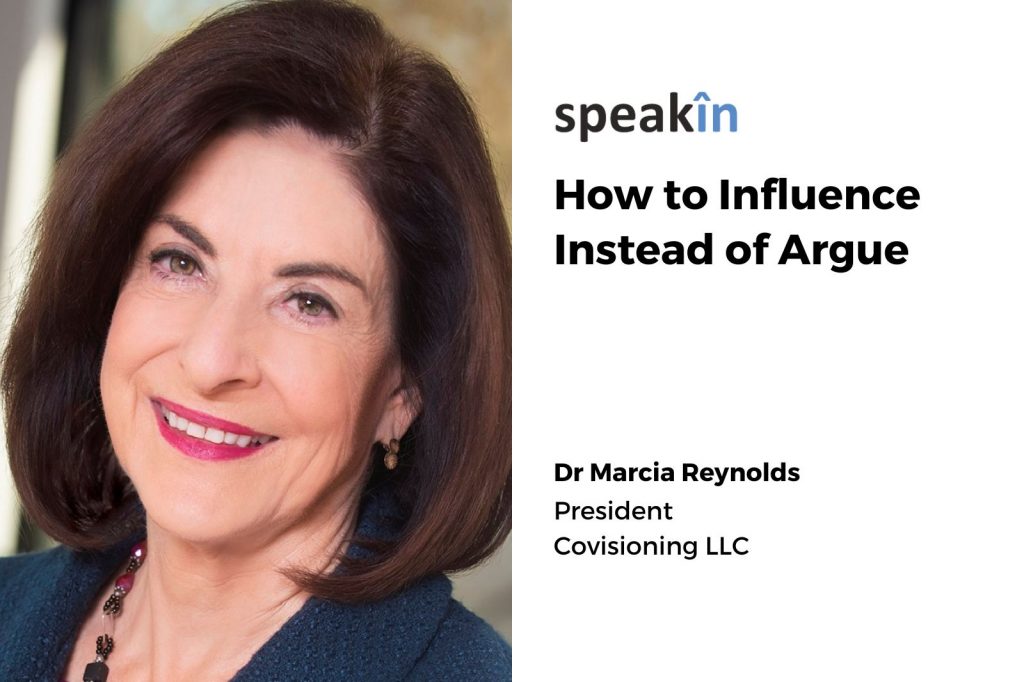How to Influence Instead of Argue

No matter how right you know you are, the person you want to convince to think differently isn’t looking for facts or logic.
To influence means you affect a change or shift in thinking. Influence doesn’t mean to force or teach someone; to influence thinking is to prompt insights that could expand the way someone thinks, possibly affecting their choices and behavior.
When you argue, trying to convince someone to see things differently, they feel as if you are making them wrong. Often, they feel as if you think they are stupid. This triggers their anger or shame. Either emotion blocks them from hearing you even if your intention is to help them grow or heal.
It is important that your intention to influence someone to see a bigger picture must be because you want them to achieve something important to them, not because you want to be right or feel heard. Let them know what goal you want to help them achieve. Or ask if a different perspective of the situation would help them understand the reasoning behind others’ beliefs or actions. They must feel your intention is to help reach their goal, or a mutual goal. Words aren’t enough. They must trust you care is genuine and you aren’t there just to get what you want.
Follow the steps below for engaging someone in a conversation. After a few minutes, you can evaluate if it feels like you might be able to move toward a mutual understanding or not.
If there has been no movement in the conversation after a few minutes, thank them for the chance to share your views and ask if you can come back to the topic in the future. Often, they will consider the value of the opportunity after your conversation is over and be more open the next time. If this doesn’t happen, then let it go if you can. You will live with less stress than trying to engage with a brick wall.
Steps to Influence Someone to See A Bigger Picture
- Start by genuinely seeking to understand the person’s perspective. They must feel you are interested in their perspective, not trying to manipulate their judgment. With care and genuine curiosity, ask open-ended questions, such as, “Help me understand how you see this situation” or “Say more about what you think is needed” or “What about this situation is important to you?” or “What do you want others to understand about the way you see things?”
- Listen for how their ideas and desires align with what you care about, too. Summarize these points so they feel heard and understood, especially on the points you both value and desire.
- Before you state your perspective, ask if there is an opening for listening. After you summarize what you hear as your mutual desires, ask, “I see the situation differently. Would you be open to hearing my perspective?”‰ÛÜ
- If they say yes, but then they interrupt to argue, you can gently remind them they said they were interested in hearing how you see things.
- If they are reluctant when you ask to share your views, tell them you notice their reluctance and ask if they would be willing to hearing you out.
- If they say no or indicate they aren’t really interested in your perspective with their gestures, then you know the conversation is over. Let them know you are sorry they can’t explore where you might align with them. Then end the conversation respectfully so your relationship stays amicable if possible.
The key to influence a change in thinking is to remain calm and caring
If you go into the conversation feeling care and respect for the person, and then remain calm throughout the interaction, your chances to influence their thinking rise. Frequently stop and take a breath to stay emotionally centered. You can find ways to regulate your emotions on this blog post, How to Manage Your Emotional Reactions
Notice when you begin to feel irritated and want to defend your point of view. Exhale and remember you are hoping for a chance to influence, not coerce their thinking. Let your tension subside. This will also give you time to assess how to relate your point of view to their perspective, or at least to recall your mutual outcome.
Notice the urge to interrupt or even insult the person. Return to your feeling of positive regard.
Does the person’s aggressiveness shut you down or elevate your anger? Remember they are protecting their point of view and self-concept, which feel challenged in the moment. If you stay calm, their emotions might subside. If their defensiveness increases, calmly state you don’t feel like you will come to a mutual understanding and would like to move on.
Do your best not to get tangled in their reactions. If you are calm, comfortable. and present to the other person, you might see opportunities to acknowledge their ideas and encourage exploration.
You can’t convince a closed mind, but you can influence someone once they open up to you.
Immerse in more interesting and engaging reads at: https://covisioning.com/brain-tips-blog/
About The Writer
Dr. Marcia Reynolds has coached leaders, delivered leadership and emotional intelligence programs, and spoken at conferences for clients in 43 countries. She has also presented at many universities including Harvard Kennedy School and Cornell University.
Marcia is a pioneer in the coaching profession. She was the 5th global president of the International Coach Federation and is one of 20 coaches recognized in the ICF Circle of Distinction. Currently, she is the training director for the Healthcare Coaching Institute in the US and on faculty of 5 coaching schools in Asia and Europe.





